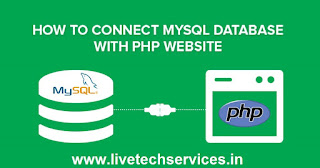You know that important thing of making any website for a business or organization comprises data, including text, images, media and numerical values. Using a database to store this data is an efficient approach for many sites. One of my friends ping me a text & ask connectivity to the database with websites. Website designing company in Delhi NCR, Live Tech Services replied him if you follow these steps so you could easily learn database connectivity. You will require a MySQL database and a web development environment using MySQL, Apache and PHP and a simple text editor.
According to me, establishing a MySQL connection using PHP on a web page, connecting to a MySQL table and retrieving the results and displaying them back on the web page.
You need to use some PHP MySQL commands:
- · mysqli_connect
- · mysqli_query
- · mysqli_fetch_array
- · mysqli_close
Strategy
- · make the connection and select the database
- · Perform the query on the table
- · print out the data
- · close the connection
1. Connecting to a MySQL database
You need your MySQL server address, username, password, and database name. Create a filenamehere.php file and open and close the PHP code with tags before the HTML, you can put regular HTML after it. If you open the file in a browser and you should see nothing apart from the title tag if you see the error the username/password or database name may be wrong. The variable $db is created and assigned as the connection string, you will be used in future steps. If there is a failure then an error message will be displayed on the page. If it is successful you will see PHP connect to MySQL.
2. Performing a database query
Actually, the MySQL query performed in the body of the HTML page so additional php opening and closing tags will be required. For the query, we are going to specify a read of all fields from a given table. The $query variable selects all rows in the table. You just need to use your table name.
If you do receive the error again ‘Error querying database’ check the table name is correct.
3. Put the data on the page
Now we are taking the making a $result variable which stores the query we just made above, now we just need to go through all the rows of that query which we need mysqli_fetch_array which stores the rows in an array, so now we are storing the $result in mysqli_fetch_array and passing that into a variable called $row.
The $row now can be output in a while loop, here the rows of data will be echoed and displayed on the page to when there is no longer any rows of data left, my example uses 4 fields in the table first_name, last_name, email, and city.
4. Closing off the connection
Closing the connection will require another set of the opening and closing PHP tags after the closing HTML tag. It is good practice to close the database connection when the querying is done.
Database connections should always be closed off. You do not need to keep the connection variable $db after the initial connection but is considered best practice.
Conclusion: Web Development Company in Noida describe database connectivity with PHP websites. They define above four points which will help you learn database connectivity.





